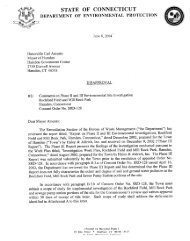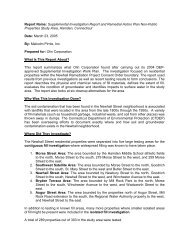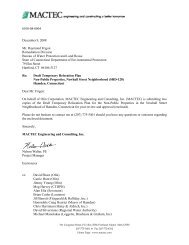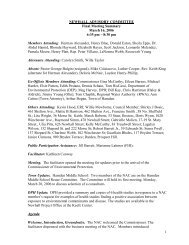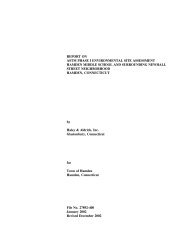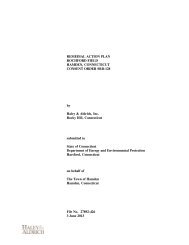Main Report - Newhall Remediation Project
Main Report - Newhall Remediation Project
Main Report - Newhall Remediation Project
- No tags were found...
You also want an ePaper? Increase the reach of your titles
YUMPU automatically turns print PDFs into web optimized ePapers that Google loves.
not tell you the source of the lead exposure. Children can be exposed to lead in various ways,including through food, drinking water, soil, and lead paint in the home. Blood tests are routinelyused by pediatricians to screen young children for potential lead poisoning. It is a good idea toget a blood lead test for all children younger than 2 years (regardless of whether they live (orspend time) in the <strong>Newhall</strong> Street neighborhood). For children, blood lead levels greater than 10µg/dL are cause for concern for possible adverse health effects. If you are concerned that yourchild or grandchild might have elevated levels of lead in their blood, you should contact theirpediatrician or the QVHD and ask about a blood test.7. Some residents asked whether their drinking water was contaminated by the landfill wastematerial.Drinking water for <strong>Newhall</strong> Street neighborhood residents comes from a public water supplyprovided by the South Central Connecticut Regional Water Authority. Drinking water comesfrom surface water reservoirs located in either North Branford or Woodbridge. These drinkingwater sources are safe and are not affected by the landfill.8. Residents asked whether there were lasting health effects from exposure to lead as a child.One of the effects that has been seen in children exposed to lead in the womb, in infancy, or inearly childhood is delayed mental development and lower intelligence later in childhood. Thereis evidence that some of these effects may persist beyond childhood.9. Many residences had elevated levels of contaminants in soil, but none were high enough towarrant immediate soil removal by EPA. Some residents are concerned that their yards are notbeing cleaned up right away and whether it is safe to continue living in their homes.Yes, it is safe to continue living in your home, even if contaminants were found in the soil, butno cleanup has yet occurred. The EPA clean-up action included only those homes with levels ofcontaminants so high that immediate action was determined to be necessary to protect publichealth. If you have contamination present in soil in your yard that has not yet been cleaned up,there are things you can do to help reduce your contact with soil until cleanup does occur. TheFact Sheet included in Attachment B provides a number of suggestions about ways to reduce soilexposure. The presence of some lead and PAHs in surface soil is common, especially near olderhomes that have or had lead paint or are near roadways with significant car and truck traffic.ConclusionsEnvironmental samples collected from residential yards in the <strong>Newhall</strong> Street neighborhoodindicate that lead, arsenic, and PAHs are present in surface and subsurface soils at elevatedconcentrations in some yards. Adults and children living in the neighborhood could be exposedto contamination while working or playing in their yards. Exposure could occur through dermalcontact (direct skin contact), ingestion (eating soil particles adhered to fingers or food), orinhalation (breathing soil particles in the air). Children have a greater potential for exposure tosoil than adults do because they play on the ground and have greater hand-to-mouth activity than25



